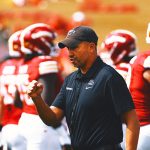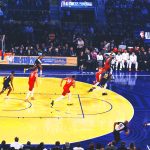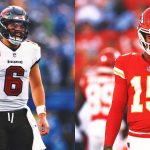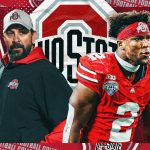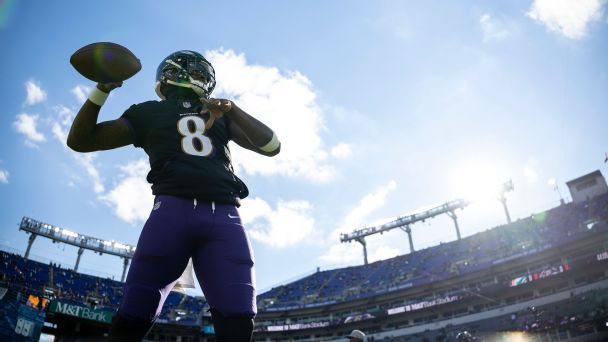
Happy New Year! To start off 2024, I’m taking a look at the best players from the 2023 NFL season, revealing my first- and second-team All-Pro selections. After working through a season of numbers, watching players on film and talking to people in and around the league about what they’ve seen, I’ve done my best to pick the top guys at every position.
In many ways, it has been a strange season, and that has impacted this roster. I typically knock down a peg players who miss a handful of games because they didn’t offer as much as those who have been on the field all season, but this season, many of the top candidates have either missed some time or come in and out of contests while battling injuries. I let availability serve as a tiebreaker on some close races, but I had to be more open-minded toward players with 13 or 14 games as viable candidates.
Subscribe: “The Bill Barnwell Show”
This is my roster, and so I build it in a slightly different way than other All-Pro ballots to try to align with real football. In a league in which teams use 11 personnel (one running back, one tight end) more often than any other personnel grouping, my teams have three wide receivers and no fullback. I list offensive linemen by individual position, so we have best left tackle and right tackle as opposed to best offensive tackles. And instead of cheating by listing some edge rushers as linebackers and others as defensive ends, I’m lumping guys such as Micah Parsons and T.J. Watt in with Myles Garrett and Maxx Crosby, since they essentially play the same role on the edge. That’s going to lead to fun consequences later.
I’ll detail my first-team All-Pros before naming my second-teamers. You won’t be surprised to hear that the top teams are well-represented: You’ll find four Ravens, 49ers and Cowboys as first-team All-Pros, making up half of the 24-man roster. That includes the quarterback, who might have locked up the MVP voting Sunday with his best game of the season:
Jump to a position:
Offense: QB | RB | WR | TE | OL
Defense: EDGE | DT | LB | CB | S
Special teams: K | P | RET

![]()
My season-ending awards column is coming next week, and there will be a heavy focus on the various quarterbacks battling for MVP. I don’t think the Ravens will play Jackson in Week 18 since they clinched the top seed in the AFC, so he’s likely to be standing on this performance as we end the regular season.
It was a good way to go out. Facing a Dolphins team whose comeback a year ago tormented the Ravens, Jackson & Co. blew out their competition for the first-round bye. Jackson was close to perfect as a passer, going 18-of-21 for 321 yards with five touchdowns. It was his first five-passing-touchdown performance since his previous MVP season in 2019. Two of his three incompletions were drops, including what should have been a 75-yard touchdown pass to Rashod Bateman.
Jackson’s case isn’t as strong as it was in 2019, when he threw 36 touchdown passes, ran for 1,206 yards and added seven more scores on the ground. Sunday’s performance got him to 24 passing touchdowns on the season. He has 821 rushing yards with five TDs this season (which is still nearly 200 more rushing yards than any other quarterback). He leads all quarterbacks in rush yards over expectation (RYOE), but 10 other quarterbacks have generated more expected points added (EPA) on the ground.
At the same time, I believe Jackson is a better passer than the guy we saw in 2019. We’ve seen the Ravens upgrade their passing game by swapping out coordinator Greg Roman for Todd Monken while importing Zay Flowers, Odell Beckham Jr. and Nelson Agholor at wide receiver, but Jackson looks more confident in the pocket. He’s averaging more yards per attempt from there than anyone in the league, besides the three Shanahan-system quarterbacks (Brock Purdy, Tua Tagovailoa and C.J. Stroud).
He also has continued to pick teams apart in the midrange (from 11 to 20 yards downfield), taking advantage of defenses that are concerned about his legs and want to get an extra safety into the run fit. He leads the league in QBR in the intermediate range (95.9), and the only quarterback who averaged more yards per attempt on those throws was Purdy. But Purdy also threw six interceptions in that zone, while Jackson didn’t turn over the ball once.
It should be noted that the competition isn’t as stiff this season as it is most years. Purdy and Tagovailoa both get knocked for benefiting from incredible playmakers and for flaming out against the Ravens in December. Dak Prescott‘s incredible two-month stretch of play has given way to three inconsistent performances over the past three weeks. Jalen Hurts has thrown 14 interceptions, and the Eagles have fallen apart since Thanksgiving. Josh Allen turned the ball over too often while the Bills were struggling in October and November. Patrick Mahomes‘ wide receivers can’t catch. It was a down season for quarterbacks, but Jackson has outlasted his competition. After having him as my midseason MVP pick, he’ll likely be there when I flip my season-long ballot over next week.
Second team: Brock Purdy, 49ers
![]()
There’s not really much competition for McCaffrey, whose regular season is likely over after he suffered a calf injury while the 49ers clinched the top seed in the NFC on Sunday. With one week to go, his 2,023 yards from scrimmage put him more than 500 yards ahead of any other back. He’s tied for the league lead in touchdowns (21) with Miami’s Raheem Mostert, who wasn’t able to go in Week 17 because of knee and ankle injuries.
The most dramatic number for McCaffrey comes from his ability to generate first downs. He has moved the chains 114 times this season. No other back has picked up more than 71 first downs through 16 games. Only 10 backs have racked up more first downs in a season since the turn of the century, and just two have done so since 2010.
McCaffrey has a lead of more than 300 rushing yards on second-place Kyren Williams, which is impressive for a back who is usually thought of as more of a hybrid player than a traditional pure runner. While the 49ers have excellent run blocking and a genius playcaller, McCaffrey is also still able to push through contact, averaging 2.1 yards after contact as a runner, which ranks seventh.
His 349 rush yards over expectation (RYOE) are nearly 100 more than those of second-place De’Von Achane; while McCaffrey has earned many more carries than the Dolphins standout, his ability to stay on the field all season has been a huge boon to his value and the San Francisco offense.
Second team: Raheem Mostert, Dolphins
![]()
While Hill’s march toward a possible MVP has been waylaid by injuries that have cost him snaps and limited his explosiveness, we’re still looking at a special season (1,717 receiving yards so far) from the league’s most productive wideout.
Hill has averaged 4.1 yards per route run, which might be unprecedented in NFL history. ESPN has yards-per-route-run data going back through 2007, and the only other player to top 3.4 over a full season was Steve Smith, who was at 3.9 in 2008. We obviously don’t have data on what Jerry Rice and others produced at their peak, but when you think about all the great receivers we’ve seen over the past 17 seasons and how far Hill is ahead of the pack, we’re talking about a true outlier.
What makes this even more impressive is that Hill gobbles up volume. He has been targeted on 37.4% of his routes this season, which is the highest rate for any player with at least 200 routes run in a season since 2007. Even with Jaylen Waddle, Achane and Mostert in the mix, he is both earning targets and generating efficiency at historic rates. This is like a peak Steph Curry season for a future Hall of Famer, even if it doesn’t end with 2,000 yards.
Second team: Puka Nacua, Rams
![]()
Seeing Lamb develop an almost preternatural connection with Dak Prescott as the season has gone along has been wildly entertaining. Through five games, Lamb had just one game with more than 80 receiving yards; he was off to a solid start, but he wasn’t on the radar as a top-five wideout.
From Week 6 onward, Lamb comfortably leads the league in catches (95) and receiving yards (1,293), more than 200 yards ahead of any other player. Mike Evans is the only wideout with more touchdowns over that time frame. As we saw Saturday night, he’s also the wideout Prescott turns to when he needs to move the chains: Lamb’s 58 first downs over that stretch also leads all receivers.
Since 2000, only seven receivers have averaged more receiving yards per game from Week 6 on than Lamb. The only one who wasn’t a first-team All-Pro was Andre Johnson in 2013. Lamb is an easy pick here; there’s a significant drop-off between Hill and Lamb and the rest of the league’s wideouts this season.
Second team: Brandon Aiyuk, 49ers
![]()
Brown is in what amounts to a dead heat with Nacua, as the two players have virtually identical numbers across the board. I’ll lean ever so slightly toward Brown for his physicality and ability to win on 50/50 balls; I wouldn’t fault anyone for preferring Nacua’s work after the catch. Brown has seven touchdown catches to Nacua’s five, and Nacua has eight drops to Brown’s three.
Nobody is having a great end to the season in Philadelphia, but Brown’s electrifying streak in midseason was enough to earn him a spot here. He became the first player since the AFL-NFL merger to rack up 125 or more receiving yards in six consecutive games. With one game left, he ranks third in receiving yards and sixth in yards per route run.
Second team: Mike Evans, Buccaneers
![]()
Kittle has been the league’s best blocking tight end for a number of years, but with Travis Kelce taking a step backward and Mark Andrews missing the final seven games of the season with an ankle injury, the 49ers star has been the best receiving tight end in football, too. Kittle leads all tight ends in receiving yards (1,020), yards per route run (2.5) and average yards after the catch (7.4).
Kittle has done that while accruing 90 targets. While I give some credence to players who are able to command huge target shares, he has been remarkably efficient when Brock Purdy looks his way. He is averaging 11.3 yards per target. No other tight end is within 3 yards of Kittle’s figure, and the only receiver who has averaged more yards per target this season is Aiyuk, Kittle’s teammate.
Second team: Sam LaPorta, Lions
![]()
Despite turning 35 before the season, Williams should be something close to a unanimous pick as the best left tackle in football. His ability to hold up on an island against every pass-rusher he faces and punish opposing defensive linemen as part of San Francisco’s expansive ground game is simply unduplicated. He did miss two games and parts of others with injuries, but this is a season in which virtually every significant lineman has missed a game or two.
Williams ranks No. 1 in pass block win rate, and if you want to see his impact on the 49ers’ offense, just take a look at what happened when an ankle injury caused him to miss those two games in midseason. A 49ers offense that has averaged 30.5 points per game with him in the lineup scored 17 points in back-to-back losses to the Vikings and Bengals. Brock Purdy has a passer rating of 118.0 with Williams on the field, but that drops to 89.0 without Williams.
Second team: Tyron Smith, Cowboys
![]()
This has been another classic Johnson season — he misses a couple of games with an ankle injury and is otherwise lights-out while protecting the right side. You can count the moments in which he looked something less than dominant on your fingers: A pressure by Keion White that forced Jalen Hurts to scramble in the season opener, an excellent rush splitting the guard and tackle by Jaelan Phillips in Week 7, and a nice move by then-Commanders edge rusher Montez Sweat in Week 8 pop up as rare exceptions to the rule.
Second team: Brian O’Neill, Vikings
1:10
What has happened to the Philadelphia Eagles?
Tim Hasselbeck explains why the Philadelphia Eagles have lost four of their last five games and how they will fare going on the road in the playoffs.
![]()
This is ESPN’s seventh season of pass block and run block win rate analysis. Over that span, no guard has posted a higher pass block win rate in a single season than Thuney, whose 99.3% mark beats out the previous record of 98.9%. Of course, the previous record holder won’t be too upset: It was Thuney, who hit that mark for the Chiefs last season. He went 426-3 on pass-block duels this season, per ESPN’s model.
Patrick Mahomes‘ propensity for improvisation asks a lot of his pass-blockers, but Thuney has been able to keep his quarterback upright, even given the disappointing play from Donovan Smith at left tackle. Thuney’s physicality also plays a key role for the Chiefs when they commit to running the football; coach Andy Reid will need Thuney and fellow interior standouts Creed Humphrey and Trey Smith to excel on the ground to give his team an offensive burst in the postseason. If you watched Sunday’s Bengals-Chiefs game, you saw Thuney springing Isiah Pacheco for a pair of big early runs.
Second team: Landon Dickerson, Eagles
![]()
Offensive linemen sometimes receive accolades well past their peak, if only because there’s no common measure we can easily rely upon to judge their performance. Ask around the league and talk to people who are watching linemen each week, however, and you’ll hear as many raves about the 33-year-old Martin now as you did five years ago. Enough of the physical tools that allowed him to play left tackle in a pinch are still around, and he has seen everything opposing defenders can throw at him by now.
Some college tackles who move inside at the NFL level can struggle with their strength or ability to hold off bigger defenders; first-round pick Peter Skoronski is dealing with that right now for Tennessee. Martin was one of the conversions who adapted immediately. He ranks fourth in run block win rate among guards this season. It still seems impossible that the Cowboys debated between picking the future Hall of Famer or quarterback Johnny Manziel in the first round of the 2014 draft.
Second team: Shaq Mason, Texans
![]()
You probably aren’t surprised, are you? Despite flirting with retirement for multiple offseasons and apparently spending his time after the Super Bowl filming dozens of commercials, the beloved Eagles center continues to look like he’s closer to 26 than 36. Philadelphia still relies heavily on Kelce’s quickness as a pulling lineman, surely asking more out of him on the move than any other center in the league. Take a look at the lead draw that won the Eagles their game against the Bills; it’s Kelce kicking out to the edge and obliterating Tyrel Dodson to set up a running lane for Jalen Hurts.
Of course, as we try to parse out the credit for why the Eagles thrive with their version of the Tush Push so much more often than their counterparts, it seems fair to give a significant portion of the credit to Hurts and some portion of it to Kelce, who consistently seems to out-leverage his opponents and create a lane for his star quarterback. Outside of a penalty for moving the ball forward against the Seahawks, it has been another banner year for the five-time All-Pro.
Second team: Frank Ragnow, Lions

![]()
Here’s the toughest competition on the list. I count nine players who could justifiably earn first-team All-Pro consideration on the edge, and that doesn’t even include Nick Bosa, who got off to a slow start before turning things on. Montez Sweat has looked like a superstar since joining the Bears. Bradley Chubb was having his best season before suffering what is reportedly a torn ACL in garbage time against the Ravens on Sunday. Khalil Mack has 16 sacks and can’t sniff my top four. It’s brutal.
Let me start with the guy who has to be on here. Watt is tied for the league lead in sacks with Trey Hendrickson, with both AFC North players at 17 with a game to go. He has stuffed the stat sheet in all kinds of ways: He has four forced fumbles, three fumble recoveries, an interception, six pass breakups and a touchdown. Big plays from Watt helped seal narrow victories for his team over the Browns, Ravens and Rams. The Steelers aren’t in the playoff picture without Watt on the field.
Second team: Myles Garrett, Cleveland Browns
![]()
By virtually every underlying pass-rush metric besides sacks, Parsons is the NFL’s best edge rusher. His 36.7% pass rush win rate is the best mark on the edge by more than six points. Myles Garrett, who would be here if not for a shoulder injury that has slowed him down over the past six games, is second at 30.5%. Nobody else is up over 26%. Will Anderson Jr., in third at 25.9%, is closer to 30th place than he is to Parsons.
ESPN’s analysis has Parsons with 69 initial pressures, placing him two ahead of Maxx Crosby for the league lead. NFL Next Gen Stats has Parsons pressuring opposing quarterbacks on 22% of dropbacks, the highest rate for a player with at least 200 pass-rush attempts this season. He has also done that while rushing the passer just 412 times, a significantly smaller total when compared to Watt (470), Aidan Hutchinson (505) and Crosby (546). His average pressure comes after just 2.17 seconds; the only other players below 2.2 seconds are teammates Demarcus Lawrence and Osa Odighizuwa, who have benefited from Parsons’ gravity this season.
Parsons has “only” 13 sacks and one forced fumble, relatively modest figures when you compare them to Hendrickson’s and Mack’s. Parsons gets triple-teamed more often than any other player. He has been criticized for his run defense in key moments, although he still ranks as a top-20 defender by run stop win rate, and I suspect the Cowboys are encouraging him to freelance a bit. Other players have taken down quarterbacks more often, but I don’t think anybody has been more impactful on a snap-by-snap basis. I would love to list five or six edge rushers here, but I have to limit myself to two.
Second team: Maxx Crosby, Raiders
![]()
The first of several Ravens defenders who made my list, Madubuike’s breakout season as an interior pass-rusher has been remarkable. While the 26-year-old flashed at times and looked to be a solid starting tackle over the previous couple of seasons, I’m not sure anybody was expecting him to be the league’s most physically imposing interior rusher in 2023.
Well, he is. Watch the Ravens every week and you’ll see Madubuike living in the backfield, simply overpowering opposing guards and forcing wild scrambles and throwaways from opposing quarterbacks. While Ravens coordinator Mike Macdonald relies on zone pressures to create confusion on the edges of protection schemes, Madubuike simply overwhelms them from the inside out.
“When you look around the league, it feels like there are two teams that are good (the Ravens and the Niners) and a bunch of other guys.” – @Foxworth24.
Much more on today’s episode with @billbarnwell and @CKravitz17 – https://t.co/wtQTLH18Ir pic.twitter.com/wl20HwABEG
— The Domonique Foxworth Show (@FoxworthShow) January 1, 2024
After quiet performance in Week 16, Madubuike’s streak of games with at least a half-sack ended at 11, leaving him one game short of the league record. He started a new one with a sack against the Dolphins on Sunday. With 13 sacks, 32 knockdowns, 12 tackles for loss and the league’s seventh-highest pressure rate for defensive tackles, it has been one hell of a contract year for a new star on the interior.
Second team: Quinnen Williams, Jets
![]()
Defensive tackle: Chris Jones, Chiefs
While Jones sat out the season opener in a contract dispute, he has been essential ever since for the Chiefs. This isn’t his most productive season by sacks or quarterback knockdowns, but he has been particularly impressive in other categories ESPN tracks. Jones ranks fifth in pass block win rate on the interior despite being double-teamed on nearly 73% of his interior rushes, which is the highest rate for any defensive tackle.
While Jones finished with 9.5 sacks, the work he did for his teammates gets the free-agent-to-be on this list. ESPN’s sacks created metric attempts to measure how many times a pass-rusher produced a sack for his team, whether that takedown was actually finished off by the player or a teammate. Jones created a league-high 18.5 sacks, helping edge defenders George Karlaftis and Charles Omenihu post career-high sack totals. Jones is the anchor for one of the league’s best defenses.
Second team: Dexter Lawrence, Giants
![]()
No off-ball linebacker erases more space and takes away the middle of the field better than Warner. While linebackers a few generations ago would take away that space with the threat of huge hits, he eliminates throws between the numbers with his speed and ability to read quarterbacks. For the second season in a row, he has allowed a passer rating south of 75 in coverage.
Warner doesn’t need to fill up the stat sheet to make a difference, but he’s having a career year. He has intercepted four passes, which is a career high. He has added 2.5 sacks and five knockdowns as a pass-rusher, along with six tackles for loss. Alongside Dre Greenlaw, Warner is part of the league’s best one-two punch at linebacker.
Second team: Quincy Williams, Jets
![]()
I had Quincy Williams in this spot before Week 17, but Smith pushed ahead of the former Urban Meyer cut in Jacksonville with a game-changing performance against the Dolphins on Sunday. Smith made a spectacular one-handed catch for an interception, then helped create a second pick by squeezing the window for a Tua Tagovailoa throw over the middle of the field.
Smith has taken a sloppy Baltimore team and turned it into a much more reliable defense. When the Ravens blew a 28-7 lead to the Dolphins last season, it was by virtue of allowing 215 yards after the catch, the sixth most for any team in a game this season. On Sunday, Smith & Co. limited what had been the league’s third-best YAC offense to 115. The Ravens have allowed the second-fewest YAC per reception this season. Much of that falls on Smith, who has made the players around him better after joining the organization via a midseason trade in 2022.
Second team: Jeremiah Owusu-Koramoah, Browns
![]()
Sneed, a fourth-round pick in 2020, emerged as a fun player around the line of scrimmage who would make a disproportionate number of plays in the backfield for a cornerback. After giving him a few games shadowing No. 1 wideouts last season, though, coordinator Steve Spagnuolo has gone all-in and given Sneed No. 1 duties for most of the season. Sneed has shut down everyone from Minnesota’s Justin Jefferson to Philadelphia’s A.J. Brown in the process.
The great @MikeClayNFL tracks CBs that shadow and L’Jarius Sneed has done so for 9 straight games.
The results for those WRs:
AJ Brown: 1 catch, 8 yards
Tyreek Hill: 8 catches, 62 yards
Courtland Sutton: 2 catches, 29 yards, 1 TD
Josh Palmer: 5 catches, 133 yards
Jerry…
— Field Yates (@FieldYates) November 21, 2023
While Sneed hasn’t made as many plays on the football as he has in previous seasons, emerging as a top-flight cover corner has been a remarkable developmental effort for Spagnuolo. And with the Chiefs blitzing at the fourth-highest rate in football, they’ve needed Sneed to win on an island on a regular basis. He has allowed a 53.1 passer rating as the nearest defender in coverage this season, according to NFL Next Gen Stats, a remarkable figure given the quality of opposition he has faced. While he has committed a league-high eight pass interference penalties this season, the pros with his performances far outweigh the cons.
Second team: Jaylon Johnson, Bears
![]()
Nobody better encapsulates the ups and downs of the Browns over the past two seasons. In 2022, Ward failed to live up to expectations and made too many mistakes. This season, he has been locked in and seemed to make plays every week. The Browns have allowed a 46.4 QBR on throws to the right side of the offense where Ward is stationed, the best mark for any team.
According to the numbers at Pro Football Reference, Ward has turned opposing quarterbacks into sub-replacement passers when they throw in his direction. He has allowed a 44.3% completion percentage in coverage, the best mark among regular starters this season. He ranks fourth among corners in passer rating allowed; the guys ahead of him are Jalen Ramsey (who would be on this list if he hadn’t missed half the season), Martin Emerson (Ward’s excellent teammate) and Jaylon Johnson, who just narrowly ended up on my second team.
Second team: Sauce Gardner, Jets
![]()
Eight interceptions and five pick-sixes speak for themselves, right? Bland is the very opposite of his name, and he is a combustible force for the Cowboys. No player has generated more points for his defense than the second-year corner.
Bland has racked up 35.6 expected points added (EPA) as the nearest defender in coverage this season, the top figure for any defensive player in the league. He has roughly been as impactful for the Cowboys as a coverage defender as Matthew Stafford has been as a quarterback for the Rams, and Stafford gets a lot more chances to play with the football.
Second team: Taron Johnson, Bills
![]()
Remember when the Ravens were forced to settle for a guy who ran a 4.59-second 40-yard dash after the Eagles moved ahead of them in the 2022 draft for defensive tackle Jordan Davis? Well, Hamilton doesn’t play like a guy who runs a 4.59. He has become the ultimate chess piece for coordinator Mike Macdonald, starring as a safety, slot cornerback and off-ball linebacker this season. He has even taken a handful of snaps as an edge rusher, where he has alternately gone after the quarterback and dropped into throwing lanes to take advantage of confused opposing signal-callers.
Hamilton has been the league’s best coverage safety. Per Pro Football Reference, he has allowed an NFL-best 38.4 passer rating across 63 targets in coverage, with opposing quarterbacks averaging just 2.6 yards per target in his direction. The NFL Next Gen Stats nearest defender model has him generating 32.4 EPA for the Ravens, which is the top mark for any safety this season and third among all defenders behind Bland and Sneed.
Get Hamilton near the line of scrimmage and he’s also a problem. He has three sacks and 15 quarterback pressures on 35 pass rush snaps; while that’s not a huge sample, nobody with more pass-rushing opportunities has gotten after the quarterback more often. He’s the first player with both 10 or more tackles for loss and pass knockdowns in a season since Tyrann Mathieu in 2015. With the Ravens dealing with injuries at cornerback throughout the season, his adaptability has been essential for one of the league’s best defenses. While he missed Sunday’s win over the Dolphins, he should be back ruining opposing offensive game plans in the postseason.
Second team: Antoine Winfield Jr., Buccaneers
![]()
Would the Falcons even be in the playoff race without Bates? In Week 1, he intercepted two passes and forced a fumble to set up 17 points in a 24-10 victory over the Panthers. His 92-yard pick-six of Derek Carr helped the Falcons capture a 24-15 win over the rival Saints. He added another pick on a deep shot in a 13-8 win over the Jets. In all, he has intercepted six passes and forced three fumbles this season. Despite playing most of the time in center field, Bates has more stuffs than any safety besides Houston’s Jalen Pitre.
Bates’ presence has helped flip the coverage success rates of both of his new team and his old one. When the Falcons didn’t get pressure last season, they ranked 27th in QBR allowed. That’s up to 10th this season. And while the Bengals — his former team — ranked 10th in QBR allowed without pressure a year ago, they’ve dropped to 29th without him. He might not single-handedly be responsible for those changes, but the Falcons are in a much better place with him in their lineup.
Second team: Justin Simmons, Denver Broncos

![]()
Aubrey is now 35-for-35 on field goal attempts this season after hitting two in Saturday’s controversial win over the Lions. It’s hard to argue with the rookie’s success, though he has missed three extra points. Aubrey has now hit nine attempts from 50 yards and beyond; over the past decade, the only other kicker to make nine or more such attempts without a miss in a season is Justin Tucker in 2016.
Second team: Dustin Hopkins, Browns
![]()
According to the methodology from Puntalytics, there’s a big four atop the punting leaderboard this season. One of those players is Tennessee’s Ryan Stonehouse, who is out for the rest of the season. Bryan Anger (Dallas) and Mitch Wishnowsky (San Francisco) are in the top three, but their offenses are too dominant; they rank among the league’s five least-used regular punters.
The one remaining player is Cole, who is averaging 50.0 yards per punt, the league’s fourth-best gross figure. His 44.8 net yards per punt are one-tenth of a yard behind Anger, but Cole has punted 71 times to Anger’s 44, giving the Raiders standout the ability to rack up considerable value as the season progresses.
Second team: Bryan Anger, Cowboys
![]()
As teams have moved more toward specialized kick and punt returners, it’s tougher for the league’s top return men to stand out from the pack over a 10- or 20-return sample. One of the few exceptions this season has been Shaheed, who has averaged more than 21 yards per kickoff return and has 321 yards and a touchdown on 23 punt returns.
Second team: Keisean Nixon, Packers

